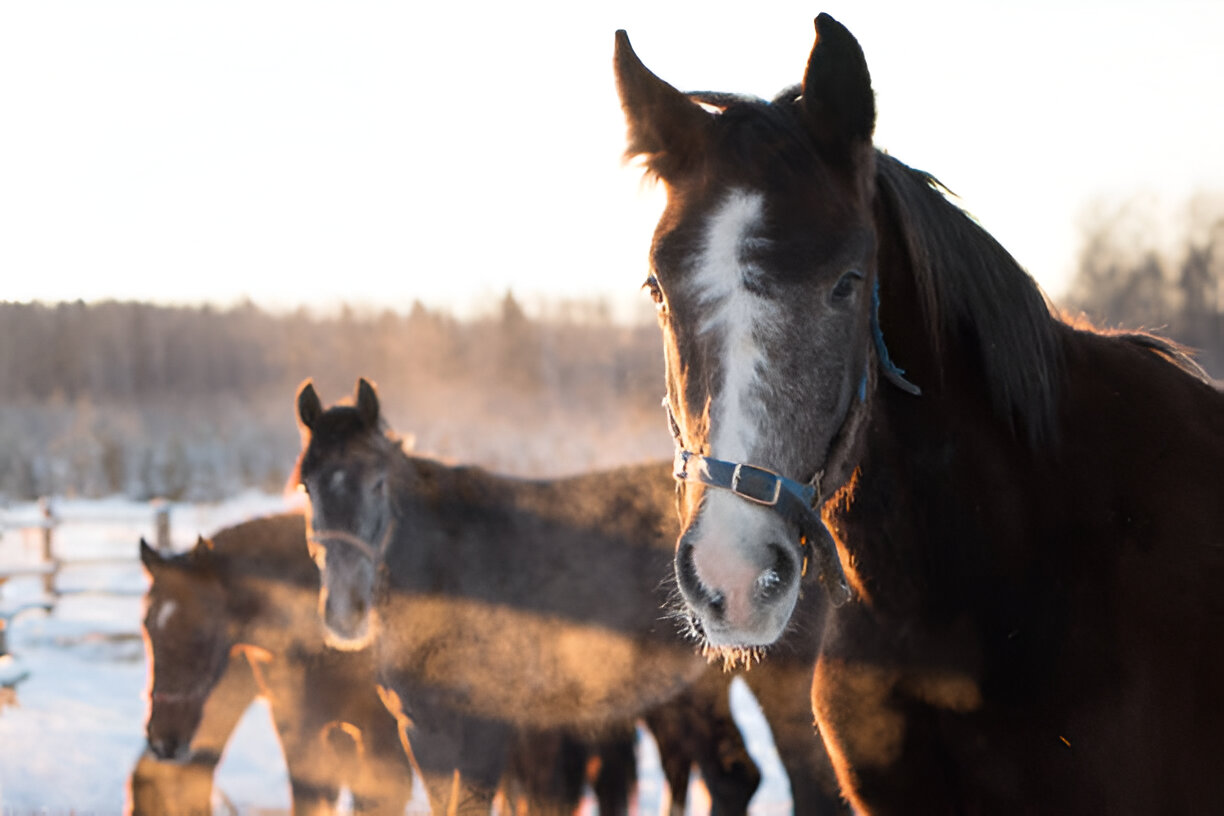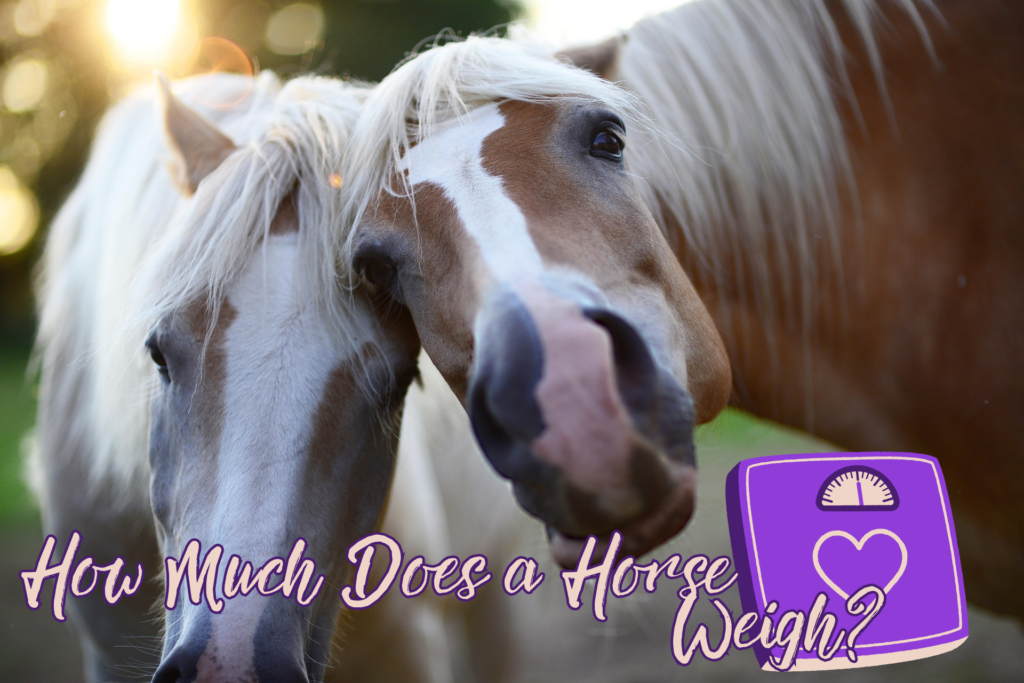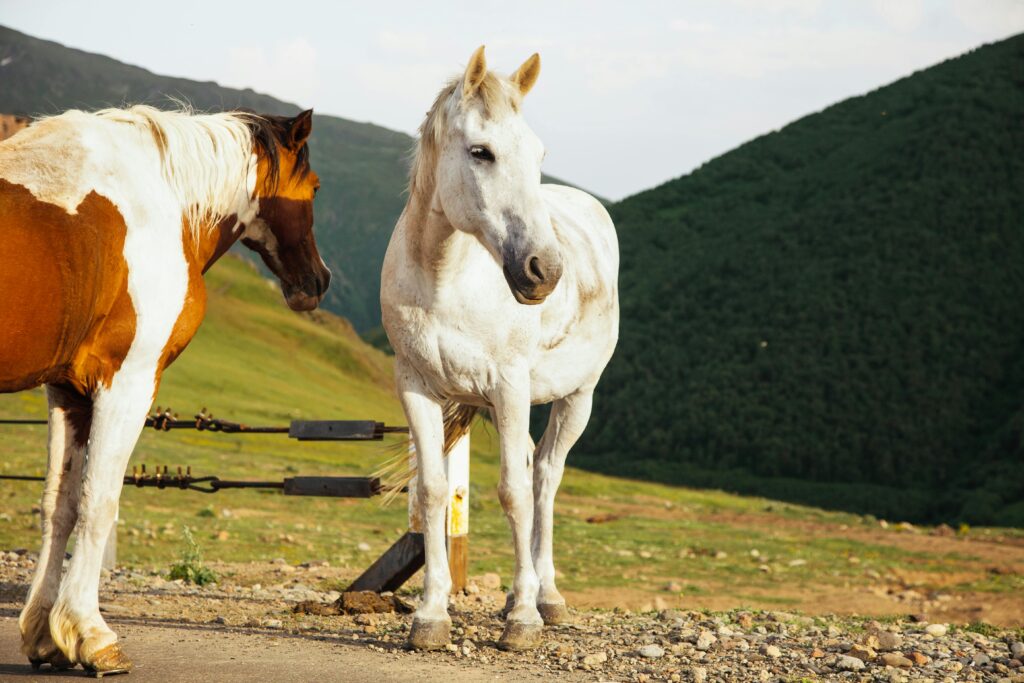How to Prepare Your Horse for Winter Weather
As winter approaches, it’s essential for horse owners to prepare their horses for the cold, harsh conditions that can affect their health and well-being. Horses can adapt to cooler temperatures, but they still require special care and attention to ensure they stay comfortable, healthy, and safe during the colder months. From adjusting their diet to providing proper shelter, winterizing your horse’s care routine is crucial.
Here are the key steps to properly prepare your horse for winter weather:
1. Adjust Your Horse’s Diet
Increase Hay Intake
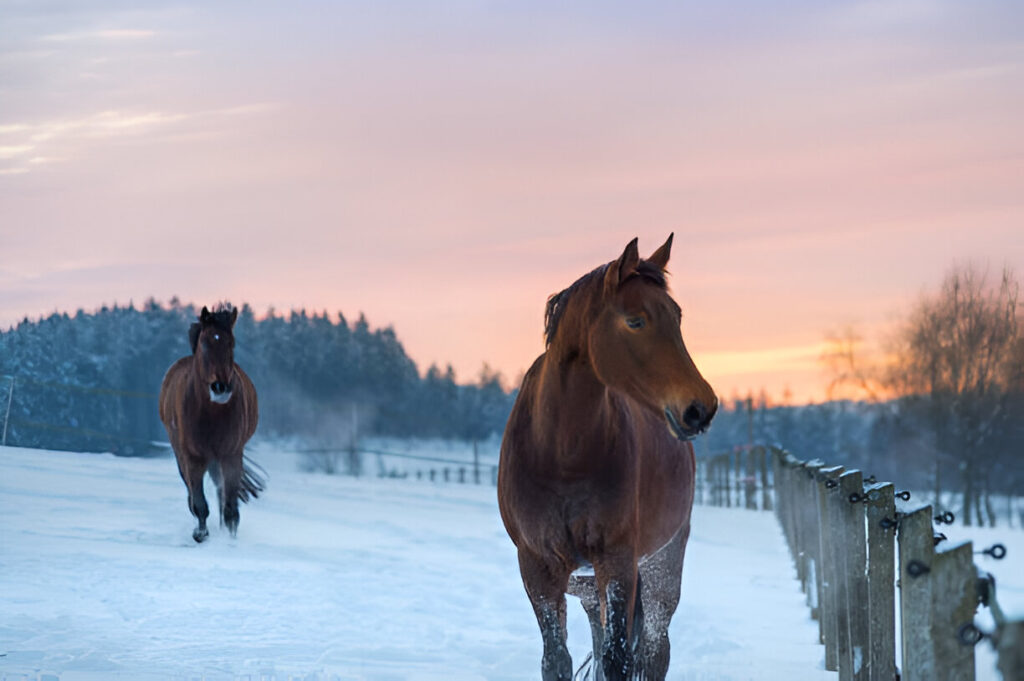
Horses generate heat through the digestion of fiber, making hay a vital part of their winter diet. During cold weather, aim to provide at least 1.5–2% of their body weight in hay daily. In extreme cold, this amount can be slightly increased to help them maintain their body temperature. Use high-quality hay and ensure it’s free from mold or dust to promote better digestion and respiratory health.
Additionally, consider offering a mix of hay types (e.g., grass and alfalfa) to balance nutrition. Alfalfa is higher in protein and calcium, which can be beneficial for horses with higher energy demands, such as broodmares or working horses.
Supplement with Grains
While hay provides the primary source of calories, grains can add concentrated energy to your horse’s diet if they require more fuel. Options such as oats, barley, or commercially prepared grain mixes can complement their needs. Remember,
sudden dietary changes can disrupt the digestive system, so any increase in grain should be gradual, introduced over 7–10 days.
Monitor your horse’s body condition score at all times in winter. Make adjustments to the grain levels and keep the horse healthy and lean and not overweight since overfeeding causes laminitis or colic.
Fresh Water
Hydration is very important for your horse, even in winter. Horses do not drink as much cold water as they do at other times, so providing warm (around 45–65°F) and palatable water can encourage consumption. Check water sources at least twice daily to ensure they’re not frozen and clean. If using heated water buckets or troughs, inspect them for safe electrical connections to prevent accidents.
Adding water to your horse’s feed, such as soaking hay or mashes, can further support hydration, especially for horses reluctant to drink cold water.
Salt and Electrolytes
Salt plays a critical role in stimulating thirst and maintaining electrolyte balance. Providing a free-choice salt block or mixing loose salt into your horse’s feed (1–2 tablespoons per day, depending on size and workload) can help ensure they’re meeting their sodium needs.
Electrolyte supplements can be especially useful for working horses or those under heavy exertion. These supplements can be fed to them or added to their water but should be introduced gradually to avoid refusal.
2. Provide Proper Shelter
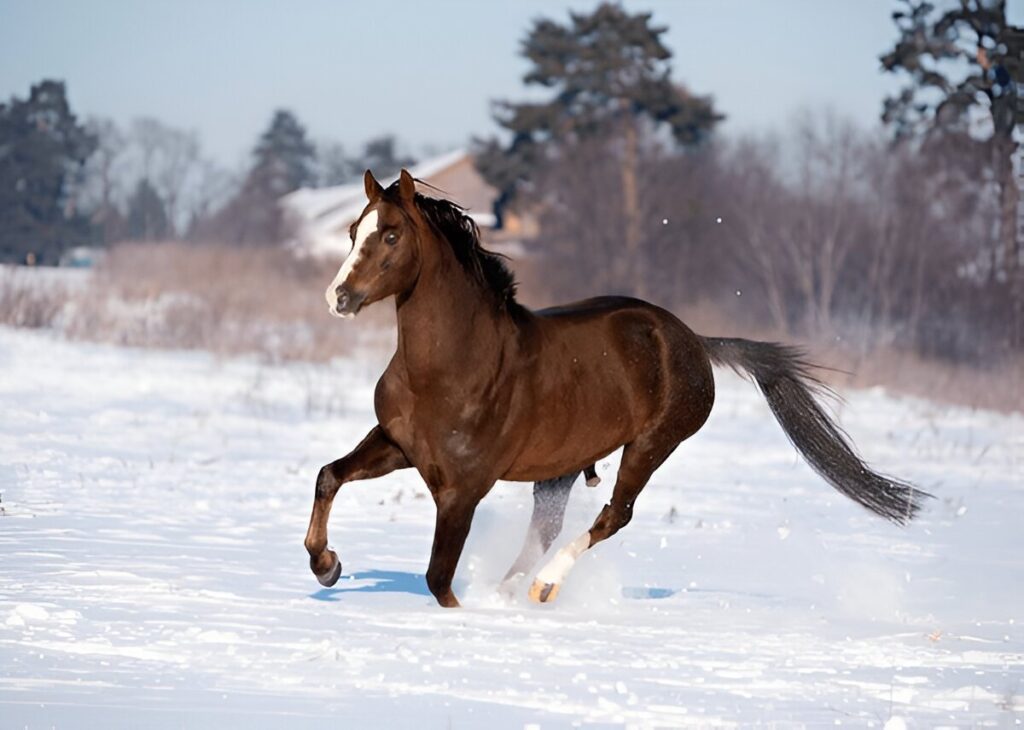
Adequate Barn or Shed Space
Even though horses are resilient and adapted to colder weather, a well-prepared shelter is vital for protecting them from harsh winter conditions. If your horse is stabled, make sure the barn is:
- Well-Ventilated:
Proper airflow is crucial to prevent respiratory issues caused by ammonia buildup from urine or damp bedding. Ventilation systems or windows that can be opened during the day are ideal. At night, close windows to keep the space warm but ensure some air exchange. - Free from Drafts:
Drafty areas can lead to discomfort or respiratory problems. Inspect walls, doors, and windows for gaps, and repair or seal them as needed. Use weather stripping or curtains in entryways to block cold air. - Spacious:
Ensure there’s enough room for all horses if multiple animals are sharing a barn or shed. Overcrowding can lead to stress and injury.
Clean Bedding
Clean and dry bedding is essential for keeping horses warm and comfortable in winter. Bedding insulates the floor, helps retain body heat, and prevents contact with cold, damp ground. Here are some tips:
- Types of Bedding:
Straw, wood shavings, or specialized horse bedding (such as pellets) work well. Straw is particularly insulating, while shavings absorb moisture effectively. - Maintenance:
Remove soiled bedding daily to reduce the risk of respiratory issues and skin problems like rain rot or thrush. Add fresh, dry bedding as needed to maintain comfort. - Depth:
Ensure the bedding is deep enough (at least 6–8 inches) to cushion and insulate. Deep bedding can also encourage horses to lie down, helping them conserve energy and stay warm.
Outdoor Shelters
Horses that live outdoors during the winter require access to a sturdy, well-designed shelter that provides protection from wind, snow, and rain. Features to consider:
- Three-Sided Design:
A three-sided shelter allows horses to enter and exit freely while protecting them from prevailing winds and precipitation. Position the open side away from the direction of the wind. - Roof and Walls:
Ensure the roof is watertight and the walls are solid enough to block wind and prevent snow accumulation inside. Use durable materials like wood or metal. - Dry and Elevated:
Locate the shelter on higher ground or provide drainage around it to prevent water pooling. A dry environment reduces the risk of moisture-related issues like mud fever. - Space:
The shelter should be enough to contain the horses so as not to overload them since, at the moment, horses could easily move without jamming together; a good thumb about 100 square feet per horse.
More Information
While not all horses require blankets, those with thin coats, older horses, or those in poor health may benefit from an insulated, waterproof blanket. Ensure it fits properly and is checked daily for adjustments.
- Windbreaks:
If a full shelter isn’t available, natural windbreaks like trees or hedges can offer some protection. Supplement these with man-made windbreaks, such as portable fencing or tarps, if needed. - Watch Conditions:
Inspect the shelter regularly to make sure it is clean, dry, and free of hazards that could include sharp edges or nails that are loose. Clear snow and ice from entryways to prevent slipping.
3. Monitor Body Condition and Groom Regularly
video by Pressmaste
Although your horse’s coat would change color during winter to help it better insulate, regular grooming is required to maintain the skin in a healthy condition and good body condition.
- Winter Coat Care Winter coat grows quite thick to provide adequate protection during winter months. The animal needs to be groomed properly in such cases without damaging its coat. There should be gentle brushing, removing loose hair, and dirt with debris from curry comb for dirt to allow easy passage through.
- Blanketing Your Horse: Depending on your horse’s breed, coat, and level of activity, you may need to use a blanket. Blankets help keep horses dry and warm, especially if they are not housed in a shelter. Always ensure that the blanket fits correctly and is made of breathable material to prevent overheating or discomfort. If your horse is kept outside, waterproof blankets are ideal to prevent moisture from seeping through.
- Hoof Care: Winter can wreak havoc on your horse’s hooves, especially when there’s a lot of moisture, ice, or snow. Regular hoof inspections are important to prevent conditions like thrush. Consider applying a hoof dressing or protective oil to help keep the hooves from drying out, and ensure they are trimmed regularly to avoid problems like cracking.
4. Exercise and Mental Stimulation
Turnout Time
Even in winter, regular turnout is crucial for the health and welfare of your horse. Fresh air and free movement are conducive to overall fitness, joint mobility, and a healthy state of mind. Here’s how to make turnout time safe and effective:
- Safe Paddock Conditions: Inspect for ice, mud, or uneven footing that could make horses slip and injure themselves. Add sand, gravel, or specialized footing to key areas for better footing.
- Shelter Availability: Ensure the paddock has adequate shelter or a windbreak in place to provide some protection against extreme weather for horses.
- Sufficient Turnout Time: For milder winter weather, longer turnout periods are ideal. In extreme cold or wet conditions, shorter turnout periods with adequate blanketing may be a better option.
- Companionship: Where feasible, provide horses with some interaction with pasture mates during turnout to fulfill social needs, minimize stress, and promote natural behavior.
Indoor Exercise
In unsafe or impractical outdoor conditions, indoor exercise allows for a controlled environment in maintaining fitness and mental stimulation. Some options include:
- Indoor Riding Arena: This type of arena is great for lots of activities: flatwork, jumping, or trail obstacles. Make sure the footing is kept up and not too dusty.
- Lunging and Long-Lining: These are excellent exercises that can be used to develop strength, improve balance, and engage the horse without much space. Pole or cone variation can make these exercises more enjoyable. Groundwork and liberty training: Practice leading, yielding, and other response to cues. Liberty training will help deepen your bond with the horse and keep their mind engaged, also strengthening the bond of trust.
- Pole Work: Even indoors, using ground poles or cavaletti can enhance coordination and flexibility. Adjust pole height and spacing based on your horse’s ability and experience.
Mental Stimulation
Winter months can be dull for horses without enough activity or enrichment. Keeping their minds engaged is just as important as physical exercise. Try these ideas:
- To counteract boredom: Provide stable toys, like balls that can be manipulated for treats or hanging toys, to amuse horses being stalled. Take advantage of this time by exposing your horse to new objects, sounds, or situations in which confidence and further trust can be built.
- Learn New Skills: Teach your horse new tricks or refine existing skills. Simple behaviors like bowing, targeting, or fetching can be fun and rewarding.
- Social Interaction: If your horse spends a lot of time indoors, consider stall-side neighbors or supervised interactions with other horses to support their social needs.
Additional Tips for Winter Exercise
Warm-Up and Cool-Down: Cold muscles are more susceptible to injury, so make sure to warm up properly before exercising and cool down afterward. Use a cooler or exercise sheet during these times to help regulate temperature.
Appropriate Gear: Utilize tack that is designed for winter conditions, including non-slip saddle pads and protective boots to protect against icy footing.
- Hydration: Encourage your horse to drink after exercise, as they may lose fluids even in cold weather. Warm water can be more palatable and encourage hydration.
5. Protect from Ice and Snow
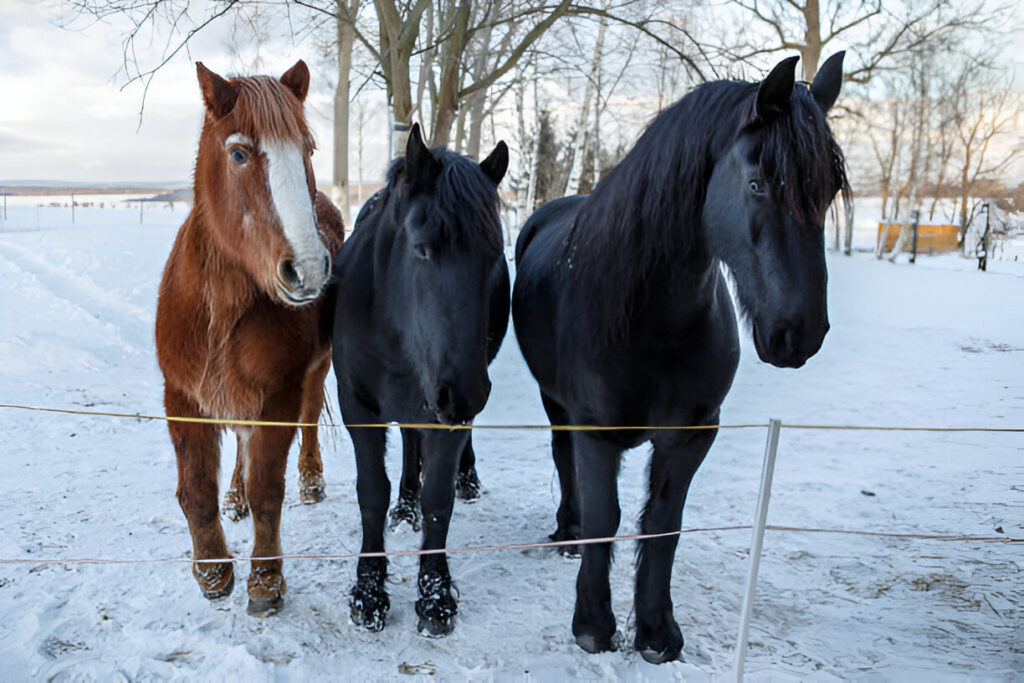
Snow and ice can be hazardous for your horse, especially when it comes to slipping and falling.
Icy Surfaces: If your horse spends time in an outdoor area with ice, make sure the footing is safe. Consider adding sand, gravel, or special non-slip footing to reduce the risk of injury. If conditions are particularly slippery, you may need to keep your horse in a safer indoor space.
Clean Feet: When your horse comes back from outside, check for snow between the hooves. Snowballing can happen when snow gets packed into the hooves and cause discomfort or lameness. Clean them with a hoof pick, ensuring there is no ice or snow that could cause issues.
Winter Shoes: If your horse is prone to slipping, consider having winter horseshoes put on. These are designed with added traction to help your horse navigate slippery conditions.
6. Preventing Winter Health Issues
The cold months can bring specific health concerns, so it’s important to be proactive in preventing them.
- Colic Risk: Colic is more common in winter due to changes in diet, decreased water intake, and less activity. Make sure your horse has consistent access to water and make changes to their diet gradually. Sudden changes in hay or grain can disrupt the digestive system.
- Respiratory Health: Cold, dry air can irritate your horse’s respiratory system. If you have a horse that is stabled for long periods, ensure the barn is well-ventilated, and minimize dust by using clean bedding and dampening hay before feeding.
- Frostbite and Hypothermia: Horses can suffer from frostbite if exposed to extreme cold and wind, particularly in areas like the ears, muzzle, or tail. Always check for signs of frostbite, such as pale or cold areas on the body. If you suspect frostbite, consult your vet immediately.
7. Check Your Horse’s Health Regularly
Regular health checks are even more critical in winter as horses may mask signs of discomfort or illness due to the colder temperatures.
- Weight and Condition: Make sure your horse is maintaining its weight, as the body uses more energy to stay warm in the winter. If your horse is losing weight or looking too thin, adjust their diet and consult your vet for advice.
- Vaccinations and Deworming: Keep your horse up to date on vaccinations and deworming. Winter is a time when respiratory issues and viruses can spread, so maintaining a proper vaccination schedule can help protect your horse.
Conclusion: Winterizing Your Horse’s Care Routine
Preparing your horse for winter weather involves more than just dressing them in a blanket. It’s about providing proper shelter, adjusting their diet, and ensuring they stay comfortable and healthy during the colder months. By staying vigilant and making the necessary adjustments, you can help your horse thrive through the winter and ensure they remain happy and healthy until the warmer months return.
Yuns Legdm is a passionate advocate for pet care and the founder of this website, dedicated to providing valuable information for fellow pet lovers and veterinary professionals worldwide. With a deep love for animals, Yuns created this platform to connect passionate pet owners with expert insights from veterinarians around the globe.
This website grows with you—the passionate pet owners and veterinary experts—creating a trusted space where knowledge, experience, and love for animals come together. Whether you’re seeking advice on pet health, nutrition, or general well-being, this platform is here to support you on your journey of responsible and loving pet care.

